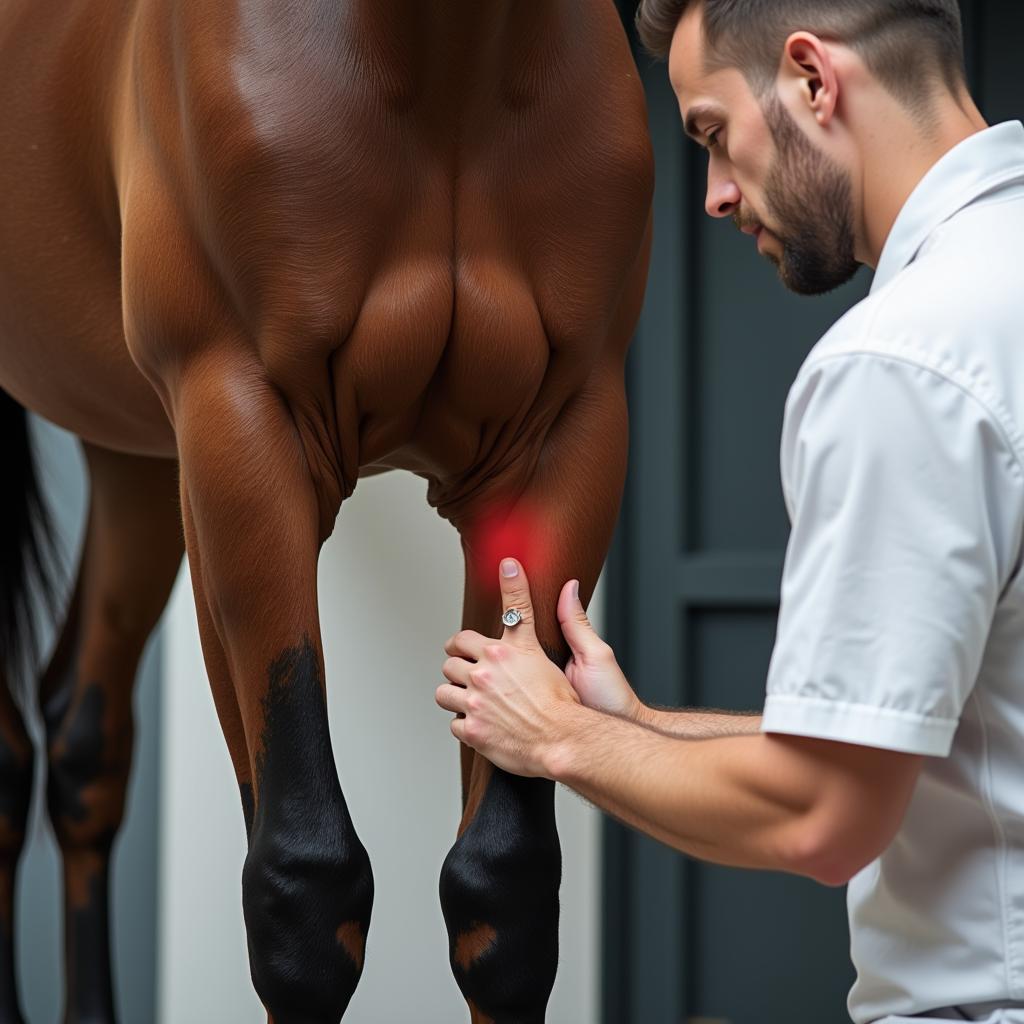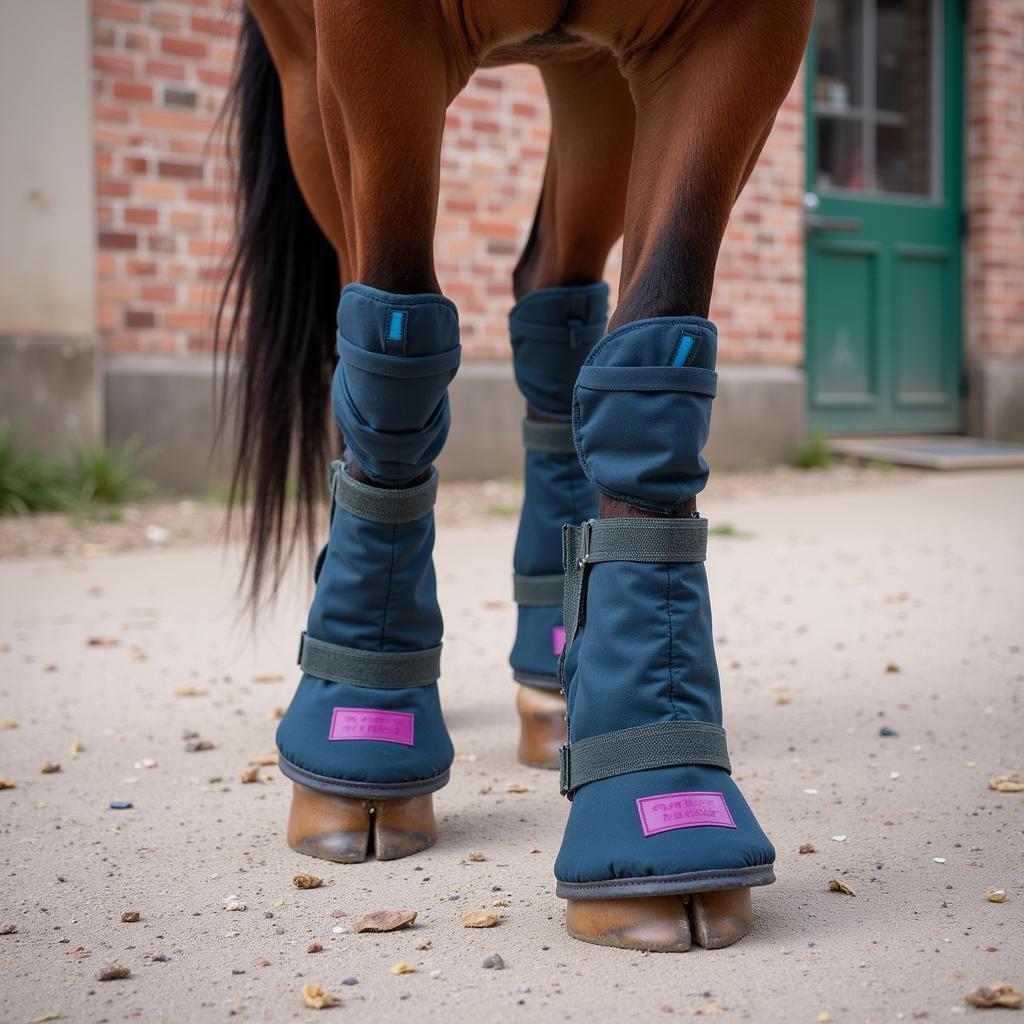As horse owners, we cherish the bond we share with our equine companions. Understanding their subtle cues and recognizing potential health concerns is paramount to their well-being. Hock pain, a common ailment in horses, can significantly impact their movement and overall quality of life. Identifying the signs early on is crucial for effective management and treatment.
Recognizing the Subtleties of Hock Pain
 Horse Exhibiting Hock Stiffness
Horse Exhibiting Hock Stiffness
Hock pain in horses can manifest in various ways, often subtly at first. Recognizing these early indicators can make all the difference in providing timely care and preventing further complications. Here are some common signs to watch for:
Changes in Gait and Posture
- Stiffness: One of the most noticeable signs is stiffness, especially after a period of rest or in the mornings. Horses with hock pain may appear reluctant to bend their hocks and might drag their hind legs slightly.
- Shortened Stride: A shortened stride in the hind limbs, particularly noticeable at the trot, is another telltale sign. The horse may seem hesitant to fully extend its hind legs, resulting in a choppy or uneven gait.
- Reluctance to Work: Horses experiencing hock pain may show a decreased willingness to perform certain movements, such as backing up, turning sharply, or engaging in activities that require significant hock flexion.
Behavioral Changes
- Irritability: Pain can make horses irritable and harder to handle. They may show signs of discomfort, such as pinning their ears, swishing their tails, or even kicking out when the affected area is touched or brushed.
- Lameness: In more severe cases, lameness in the hind limbs can occur. This might range from a subtle head nod to a more pronounced limp, depending on the severity of the pain.
Physical Indicators
- Swelling: Swelling around the hock joint can indicate inflammation, often associated with hock pain.
- Heat: Increased heat in the hock area, compared to the surrounding tissues, is another sign of inflammation.
- Pain on Palpation: Horses with hock pain may flinch or react negatively when the hock joint is touched or manipulated.
 Veterinarian Conducting a Hock Exam
Veterinarian Conducting a Hock Exam
Understanding the Hock Joint
The hock joint, also known as the tarsus, is a complex structure in the horse’s hind leg. It plays a crucial role in supporting the horse’s weight and facilitating movement. Due to its complexity and the significant stress it endures, the hock joint is susceptible to various injuries and conditions that can lead to pain and lameness.
Common Causes of Hock Pain in Horses
Hock pain can stem from a range of issues, from acute injuries to chronic conditions. Some of the most common causes include:
- Osteoarthritis: This degenerative joint disease, also known as arthritis, is a leading cause of hock pain in horses. It involves the breakdown of cartilage within the joint, leading to inflammation, pain, and stiffness.
- Bog Spavin: Bog spavin refers to an excess of synovial fluid, the lubricating fluid within the joint, which causes swelling in the front pouch of the hock.
- Bone Spavin: Unlike bog spavin, bone spavin involves bony changes in the lower hock joints, leading to pain and fusion of the joints.
- Curb: Curb is an inflammation or injury to the plantar ligament, located on the back of the hock, and can cause pain and swelling in that area.
Diagnosing Hock Pain
If you suspect your horse is suffering from hock pain, it’s essential to consult with a veterinarian experienced in equine lameness. They will conduct a thorough examination, which may include:
- Physical Exam: Observing the horse’s posture, gait, and palpating the hock joint for any signs of swelling, heat, or pain.
- Lameness Evaluation: Assessing the horse’s movement at various gaits to pinpoint the source and severity of the lameness.
- Diagnostic Imaging: X-rays, ultrasounds, or other imaging techniques may be employed to visualize the internal structures of the hock joint and identify any underlying issues.
 Horse Wearing a Hock Ice Boot
Horse Wearing a Hock Ice Boot
Treatment and Management
Treatment for hock pain depends on the underlying cause and severity of the condition. Options may include:
- Rest and Restricted Activity: Reducing the horse’s workload and providing stall rest are often the first steps in managing hock pain. This allows the inflamed tissues to heal and minimize further stress on the joint.
- Cold Therapy: Applying ice to the affected area can help reduce inflammation and alleviate pain. Using horse hock ice boots can effectively target the area.
- Medications: Non-steroidal anti-inflammatory drugs (NSAIDs), such as phenylbutazone (Bute) or flunixin meglumine (Banamine), can be prescribed to reduce inflammation and relieve pain. In some cases, corticosteroids may be injected into the joint to provide more targeted anti-inflammatory effects.
- Supplements: Certain horse arthritis supplements can aid in supporting joint health and may help slow down the progression of degenerative joint diseases.
- Physical Therapy: Targeted exercises and therapies, such as stretching, massage, and laser therapy, can help improve range of motion, reduce muscle soreness, and promote healing.
- Surgery: In more severe cases, surgery may be necessary to address specific issues, such as removing bone fragments or fusing joints affected by bone spavin.
Prognosis and Prevention
The prognosis for horses with hock pain varies depending on the underlying cause, the severity of the condition, and the horse’s individual response to treatment. Early diagnosis and intervention are crucial for improving the horse’s long-term outcome.
While not all causes of hock pain are preventable, some measures can be taken to minimize the risk:
- Regular Veterinary Care: Scheduling routine veterinary check-ups, including lameness evaluations, can help identify potential problems early on.
- Proper Conditioning and Warm-up: Ensuring horses are adequately conditioned and receive proper warm-up before exercise can help prepare their joints for the stress of work.
- Balanced Nutrition: Providing a well-balanced diet that meets the horse’s nutritional needs is essential for supporting joint health.
- Appropriate Footing: Maintaining good quality footing in pastures and riding arenas can reduce concussion and stress on the joints.
When to Seek Veterinary Attention
If you notice any signs of hock pain in your horse, it’s crucial to contact your veterinarian promptly. Early detection and treatment can significantly impact your horse’s comfort and long-term well-being. Don’t hesitate to reach out to a professional if you have any concerns about your horse’s health.
Frequently Asked Questions
1. Can hock pain in horses be cured?
The possibility of a cure depends on the underlying cause. While some conditions, such as osteoarthritis, are chronic and require ongoing management, others, like soft tissue injuries, may heal completely with appropriate treatment.
2. How long does it take for hock pain in horses to heal?
Healing time varies depending on the severity and cause of the pain. Mild cases might improve within a few weeks, while more severe conditions may require months of rehabilitation.
3. What are some Signs Of Hock Pain In Horses that owners often miss?
Subtle signs like slight tail swishing, reluctance to back up, or a change in temperament during saddling can be early indicators.
4. Are certain breeds of horses more prone to hock pain?
Yes, some breeds, particularly those with heavily muscled hindquarters or those bred for specific disciplines involving strenuous hock movements, may be more susceptible.
5. Can I prevent hock pain in my horse?
While not all causes are preventable, maintaining good hoof care, providing proper conditioning and warm-up, and ensuring adequate nutrition can help minimize risks.
Need More Information?
Explore these related articles for further insights:
- Full Leg Ice Boots for Horses: Learn about the benefits and uses of full leg ice boots for equine therapy and injury recovery.
- Flattened Horse: Discover the causes and potential solutions for a “flattened” horse, a condition often associated with muscle loss and weakness in the hindquarters.
Remember, your horse’s well-being is our priority. For personalized advice and support in managing hock pain in your equine companion, don’t hesitate to contact us at Justus Horses USA.
Call: 0772127271
Email: [email protected]
Visit Us: QGM2+WX2, Vị Trung, Vị Thuỷ, Hậu Giang, Việt Nam
Our dedicated team is available 24/7 to assist you.